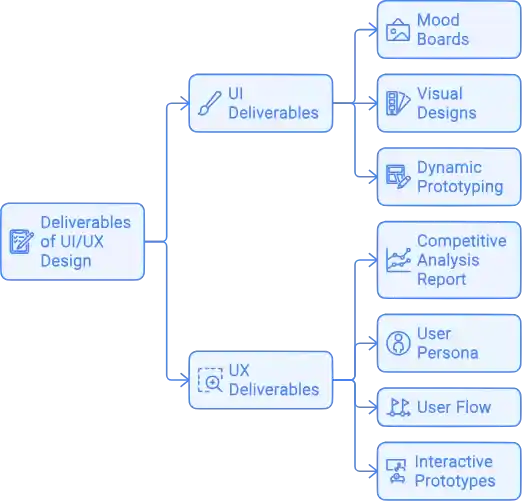Table of Contents
In today’s fast-paced digital world, the success of an app largely depends on how well it engages users and provides them with a seamless experience. This is where UI (User Interface) and UX (User Experience) design come into play. Understanding the importance of UI/UX design in app development process can be the difference between an app that thrives and one that fails. This comprehensive guide explores the key elements of UI/UX design, its deliverables, and why it is crucial for mobile app development.
The process of creating a mobile application involves numerous stages, from ideation to development and deployment. However, one of the most critical aspects is often overlooked: UI/UX design. A well-designed interface coupled with a positive user experience can significantly enhance the app’s appeal, functionality, and overall success.
UI/UX Design: An Overview
UI and UX design are two interdependent components that play a vital role in the app development process. There is a great Importance of UI/UX Design in App Development Process.
- UI Design: Focuses on the visual aspects of the app, including the layout, colors, typography, and interactive elements. It is all about creating an attractive and intuitive interface that users find easy to navigate.
- UX Design: Involves enhancing the overall experience of the users as they interact with the app. It encompasses the usability, accessibility, and efficiency of the app, ensuring that users find value and satisfaction in using the app.
Components of UI/UX Design
The process of UI/UX design can be divided into three main parts:
- This initial stage involves gathering detailed information about the users, their needs, and their behaviors. It includes creating user personas, conducting surveys, and analyzing market trends. The goal is to understand the target audience deeply to inform design decisions.
Wireframing and Prototyping
- Wireframes are detailed structural sketches that illustrate the app’s concept. They act as blueprints, clearly showing how the app functions and the core elements of its design. Prototypes are interactive models that simulate the user interface and user experience, allowing for early testing and feedback.
Visual Designing and Testing
- This stage involves creating the final visual design, including all graphical elements and user interface components. It also includes testing the design to ensure it meets user needs and performs well under various conditions.
Deliverables of UI/UX Design

UI Deliverables
Mood Boards
- Mood boards present innovative ideas visually, helping clients understand the app concept and design direction.
Visual Designs
- These include detailed designs that showcase the effects of elements like photography, typography, space, colors, layouts, and images.
Dynamic Prototyping
- Prototypes improve the app’s overall functioning and allow for iterative improvements. They help visualize how the UI will look and feel in the final product.
UX Deliverables
Competitive Analysis Report
- This report measures the level of competition your app faces and identifies the strengths and weaknesses of competitors’ apps.
User Personas
- User personas represent the app’s target audience, detailing their needs, behaviors, and expectations.
User Journeys, Experience Maps, and User Flows
- These visual tools map out the user’s interactions with the app, highlighting key touchpoints and potential pain points.
Interactive Prototypes
- Interactive prototypes demonstrate how the actual product will work once fully developed. They help in communicating design ideas and gathering user feedback.
Importance of UI/UX Design in App Development
Better User Retention
User retention is crucial for the success of an app. A well-designed interface and seamless user experience ensure that users stay engaged and keep coming back to the app. Users interact with the interface, not the code, making UI/UX design pivotal for retention.
Effective and Enjoyable Interaction
UI/UX design facilitates effective and enjoyable interactions between users and the app. The primary goal is to provide the best possible interaction, ensuring users find the app easy and enjoyable to use.
Turning Customers into Loyal Customers
A positive user experience encourages users to become loyal customers. The structure of the app, designed with user experience principles, helps create a lasting impression and fosters customer loyalty.
Saving Resources in the Long Run
Investing in UI/UX design from the start can save significant resources in the long run. It prevents the need for frequent redesigns and ensures the app can compete effectively with well-designed applications in the market.
Communicating Your Mission and Product/Service
Visual elements and copywriting are crucial in communicating the brand’s mission and the app’s offerings. Good UI design, coupled with compelling copywriting, can create a lasting impression on users.
Scaling the Application with Mobile UI/UX Design
Mobile UI/UX design helps scale the application to reach more users. Concepts like repetition, alignment, and contrast become even more important in mobile design due to limited screen size and the need for clear visuals.
Beyond Design: The Holistic View of UI/UX
UI/UX design goes beyond just the interface. It involves researching user needs and presenting these insights to the business team. This holistic approach ensures that the app is designed with the user’s needs at the forefront, improving the overall product.
Design Trends for 2024

Staying updated with design trends is crucial for creating modern and appealing apps. Some of the key trends for 2024 include:
- Minimalistic Design: Focus on simplicity and clarity, reducing clutter to enhance user experience.
- Dark Mode: Offering a dark mode option for apps to reduce eye strain and improve battery life on devices with OLED screens.
- Microinteractions: Small animations or responses to user actions that enhance the interactivity and enjoyment of the app.
- Voice User Interface (VUI): Incorporating voice commands and interactions to provide a hands-free user experience.
- Augmented Reality (AR): Integrating AR features to create immersive and interactive user experiences.
Key Elements of a Good Mobile App Design
Information Architecture
Ensuring users can navigate the app easily, regardless of the browser they are using. It focuses on providing a top-level navigation experience.
Interaction Design
Creating a conceptual design through which users interact with the app, including elements like colors, aesthetics, icons, fonts, and images.
Usability
Ensuring that users can find the information they need and handle issues on their own. Usability focuses on providing a self-serving way for users to interact with the app, and usability testing plays a crucial role in identifying pain points, improving navigation, and optimizing the overall user experience.
Wireframe
Creating a sample of the app for testing features, usability, and appearance before it goes live. Wireframes help in visualizing the app’s structure and functionality.
Visual Design
Defining the app’s brand in the users’ eyes. It involves choosing the best colors, icons, images, and fonts, and ensuring the app’s appearance impacts users positively throughout their interaction.
Benefits of UI/UX Design in App Development
To understand the importance of UI/UX design in app development, it’s essential to recognize its multifaceted impact on user engagement, satisfaction, and overall success. Here are several key benefits of UI/UX design:
Attracts Users
A well-designed app captures users’ attention and keeps them engaged. A good user interface, combined with a seamless user experience, ensures users spend more time on the app.
Creates a Good Impression
First impressions matter. An attractive and intuitive UI/UX design helps create a positive first impression, encouraging users to return to the app.
Gets Featured in App Stores
Apps with excellent UI/UX design are more likely to receive positive ratings and reviews, which can lead to being featured in app stores. This increases visibility and attracts more users.
Gains Loyal Customers
A positive user experience leads to satisfied users who are more likely to become loyal customers. They will return to the app, recommend it to others, and provide valuable feedback for improvements.
Saves Time and Cost in the Long Run
Investing in UI/UX design from the beginning can save time and money by reducing the need for frequent updates and redesigns. A well-designed app is easier to maintain and update.
Builds Brand Credibility
A well-designed app enhances brand credibility and trust. Users associate a high-quality app with a reputable brand, increasing their confidence in your products or services.
Increases User Traffic
An app with a good UI/UX design attracts and retains more users. The better the user experience, the more likely users are to explore and use the app’s features.
If you’re looking for expert assistance in creating an exceptional app experience, consider partnering with a Drupal web design agency that can provide comprehensive UI/UX solutions tailored to your needs.
Conclusion
UI/UX design is not just about aesthetics; it’s about creating a functional, enjoyable, and intuitive user experience. A well-designed app can significantly enhance user satisfaction, retention, and loyalty, ultimately contributing to the app’s success. By understanding the importance of UI/UX design and implementing best practices, developers can create apps that stand out in the competitive market.